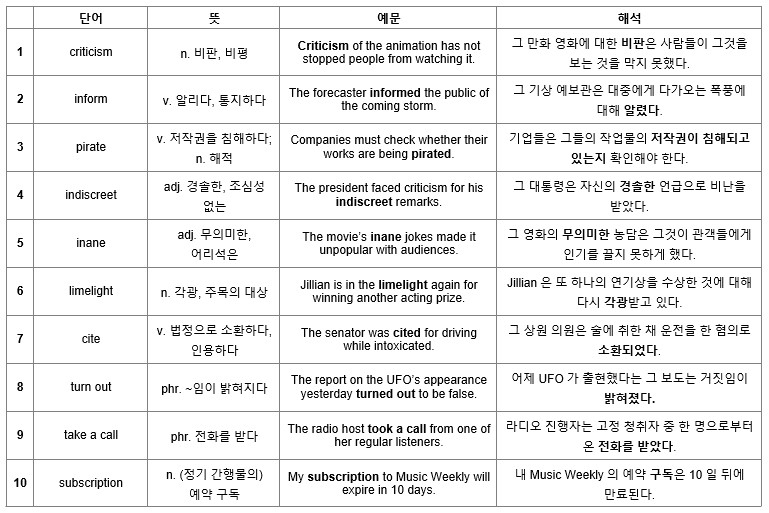



2) 해커스 텝스 문법
Part Ⅰ Choose the best answer for the blank.
1.
A: What happened? Why were you late for the meeting?
B: I’m sorry. _______ I left home early, my car broke down on the way here.
(a) In case
(b) Although
(c) Even
(d) Despite
해석
A: 무슨 일이에요? 왜 회의에 늦으신 건가요?
B: 미안합니다. 비록 제가 집에서 일찍 출발했지만, 이곳으로 오는 길에 제 차가 고장 났어요.
해설
적절한 부사절 접속사 채우기
빈칸이 포함된 문장은 주어(my car)와 동사(broke)를 갖춘 완전한 문장이므로, 빈칸 이하는 수식어 거품으로 보아야 한다. 이 수식어 거품은 주어(I), 동사(left), 목적어(home)을 갖춘 완전한 절이므로, 완전한 절을 이끌 수 있는 부사절 접속사 (a)와 (b)가 정답의 후보이다. ‘비록 제가 집에서 일찍 출발했지만 늦었다’라는 문맥이 되어야 하므로 ‘비록 ~이지만’이라는 뜻의 부사절 접속사 (b) Although가 정답이다. 강조 부사 (c)와 전치사 (d)는 절을 이끌 수 없으므로 오답이다.
어휘
break down 고장이 나다
2.
A: Our server has a glitch.
B: Don’t worry, surely the I.T. department ______ it soon.
(a) has fixed
(b) will fix
(c) fixed
(d) fix
해석
A: 우리 서버에 결함이 있어요.
B: 걱정 마세요, 분명 IT 부서가 곧 고쳐줄 겁니다.
해설
적절한 시제의 동사 채우기: 미래
A가 현재 ‘서버에 결함이 있다’고 했으므로, B가 말한 soon(곧)은 ‘미래’일 것이다. 따라서 미래 시제 (b) will fix가 정답이다.
어휘
glitch (사소한) 결함, 문제 surely 분명
Part Ⅱ Choose the best answer for the blank.
3.
_______________________________ to class than her history teacher announced a surprise quiz.
(a) No sooner Bella had arrived
(b) No sooner had Bella arrived
(c) Bella had arrived no sooner
(d) Bella no sooner had arrived
해석
Bella가 교실에 도착하자마자 그녀의 역사 선생님이 깜짝 퀴즈를 공지했다.
해설
‘no sooner + had + 주어 + p.p.’ 채우기
모든 보기에 온 no sooner는 부정의 의미를 나타내는 부사이므로, 강조되어 문장의 맨 앞에 오고 조동사가 주어 앞으로 도치되어야 한다. 따라서 ‘No sooner+조동사(had)+주어(Bella)’의 어순을 올바르게 표현한 (b) No sooner had Bella arrived가 정답이다. 참고로 no sooner는 빈도 부사와 같이 조동사 뒤, 일반동사 앞에 오는 것을 알아둔다.
어휘
announce 공지하다, 발표하다 surprise quiz 깜짝 퀴즈
4.
The documentary talks about why people should be concerned about global warming and how _______________ this phenomenon.
(a) to deal
(b) to deal with
(c) dealing
(d) dealing with
해석
그 다큐멘터리는 사람들이 지구 온난화에 대해 걱정해야 하는 이유와 이 현상을 어떻게 다뤄야 하는지에 대해 이야기한다.
해설
to부정사 자리 채우기
빈칸이 있는 구(how ____________ this phenomenon)는 등위접속사 and로 동등하게 연결된 구(why people should ~ warming)와 함께 동사 talks의 목적어가 되어야 하고 빈칸 앞에 의문사 how가 있으므로, 의문사 다음에 와서 동사의 목적어로 쓰일 수 있는 to부정사 (a)와 (b)가 정답의 후보이다. 보기에 있는 동사 deal은 전치사 없이 목적어(this phenomenon)를 바로 가질 수 없는 자동사이므로 전치사 with가 포함된 (b) to deal with가 정답이다.
어휘
concern 걱정하다 phenomenon 현상 deal with ~을 다루다, 처리하다
Part Ⅲ Identify the option that contains an awkward expression or an error in grammar.
5.
(a) In 1912, Alfred Wegener hypothesized that during the late Paleozoic era, the continents were once part of a single supercontinent known as Pangaea.
(b) He believed that Pangaea began breaking apart into smaller landmasses about 200 million years ago.
(c) Pangaea then continued to drifting apart and bodies of water started to form between the subcontinents.
(d) His theory was not accepted until the 1960s, when sufficient evidence supporting his ideas was found.
해석
(a) 1912년, Alfred Wegener는 후기 고생대 시대 때 대륙들이 한때 판게아라고 알려진 단일 초대륙의 일부였을 것이라는 가설을 세웠다.
(b) 그는 약 2억 년 전에 판게아가 더 작은 대륙들로 쪼개지기 시작했을 것이라고 믿었다.
(c) 그 뒤 판게아는 계속해서 간격이 멀어지고 수역이 아대륙 사이에서 형성되기 시작했다.
(d) 그의 이론은 그의 의견을 지지하는 충분한 증거들이 발견된 1960년가 되어서야 수용되었다.
해설
to부정사의 형태가 틀린 문장 찾기
(c)에서 to 뒤에 –ing 형인 drifting이 오면 틀리다. continue는 to부정사 혹은 동명사를 목적어로 취하는 타동사인데, 뒤에 to가 왔으므로 to부정사를 완성하는 ‘to + 동사원형’이 와야 한다. 즉, to drifting은 to drift로 바뀌어야 맞다. 따라서 (c) Pangaea then continued to drifting apart and bodies of water started to form between the subcontinents가 정답이다.
어휘
hypothesize 가설을 세우다 Paleozoic 고생대의 era 시대 continent 대륙
supercontinent 초대륙, 거대 대륙 landmass 대륙, 땅덩어리 drift apart 간격이 멀어지다
body of water 수역 subcontinent 아대륙 sufficient 충분한
.
.
.
.
.
정답
(b) / (b) / (b) / (b) / (c) to drifting → to drift
✅ 설미연쌤 텝스인강 0원으로 무제한 수강 ▶ https://gouk.kr/rFxtbv
✅ 텝스 전레벨 교재 제공! 327/387 한번에 달성 ▶https://gouk.kr/wh2FDS
✅ 내 텝스 실력 무료로 확인하고 텝스인강 할인쿠폰까지! ▶ https://gouk.kr/aMCRNn






![[Today’s K-pop] Blackpink’s Jennie, Lisa invited to Coachella as solo acts](http://res.heraldm.com/phpwas/restmb_idxmake.php?idx=644&simg=/content/image/2024/11/21/20241121050099_0.jpg)
